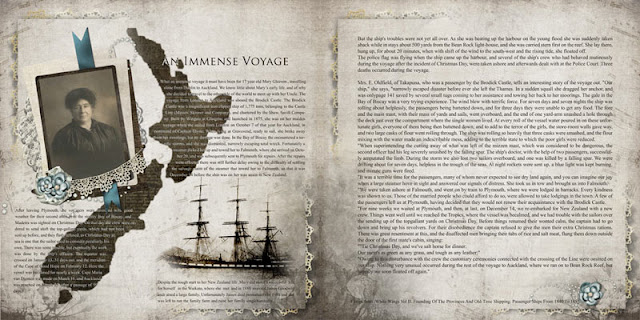One of my most interesting family branches is the McClellan/Brodie branches.
My maternal Grandmother was a McClellan, and it is her grandparents that form the basis of a MOST interesting story. I still am in the throes of researching and Im sure it wont be a quick job but what Ive learned so far would make for a great family saga novel!!
We can start the story in Stronsay, in the Orkneys in the far far north of Scotland .
One Betsy BRODIE ( born about 1838 ) daughter of John and Eliza BRODIE married one John LENNIE, a blacksmith in July 1841.
They had 3 children, David, John Gorrie and Catherine and in 1870 when Catherine was not yet 2 they made the long voyage far south to New Zealand, aboard the ship “Merope “

Its a little hard to distinguish but the notation on the side indicates they were heading for Kowhai Pass, but for whatever reason they settled in Pleasant Point.
They had a further 2 children, in 1871 and 1875 and then sadly in July 1876 John Lennie died aged just 42, widowed with 5 children, it appears Betsy Brodie didnt waste time and in February 1877 she married William McClellan, a fellow Scot, from the Isle Wighorn. ( She married as Elizabeth Brodie not Lennie)
In July 1877 she had a further child, also named William McClellan ( my Great Grandfather) .
From this time onwards their life is a bit of a mystery which Im still researching. It appears Willliam took the children as his own, some of them even used the McClellan surname later in life. John Gorrie died aged 17. Catherine married at age 16 to a man 17 years her senior and had 12 children in the subsequent 18 years before dying in childbirth.
William ( and it appears John Lennie before him) was a member of various lodges in Pleasant Point including the Independent Order of Good Templars.
This testimonial though from the Salvation Army “War Cry” gives you a wonderful insight into the man who appears to have been quite the character.
“ A sinner, saved by grace through the instrumentality of the Salvation Army, an old man-of-war’s man, a hard smoker and chewer of 43 years, at one time a terror to the Army,but now a Salvation Soldier”
Sometime after their marriage, the family moved from Pleasant Point, near Timaru, to Woodville in the South Hawkes Bay/Manawatu area.
Quite a strange move for those days I would say, and I’m not sure of the reason but it appears they became boarding house keepers, managing the Post Office Temperance Hotel in Woodville which came up for sale in 1887
 .
.
You can see an old photo of the hotel from the Alexander Turnbull Library Archives here. The building in fact is still standing – currently the Atmosphere Gallery.
Sadly though , in 1894 Betsy was to be widowed for a second time, when William died , aged 56 of Cancer of the Stomach

There were several small notices in the Woodville Examiner regarding Williams death.
The Woodville Examiner Friday December 14 1894
We regret to record the death of Mr McClellan, of the Post Office Temperance Hotel. Deceased was for many years a seafaring man. About six months ago his health began to fail, and it was ascertained that he suffered from cancer of the stomach, the disease gaining head way till resulting in his death yesterday afternoon. Deceased leaves a widow and son. The funeral will take place on Sunday at 2pm.
and then over the next couple of weeks the following items were printed
“Mr Sandel has kindly undertaken to have raffled a large picture worked in wool by the late Mr McClellan, the proceeds of which will go the widow and family. There are 48 tickets of 5s each, and there are still about 20 tickets to be taken up. The permission of the Colonial Secretary has been obtained to the disposal of this picture in the above manner. As soon as the remaining tickets are taken up the date of the drawing will be duly notified.”
Drawing for Picture by Late Mr McClellan
As the list of members for the raffle for the large picture worked in wool, is now filled up, all interested in same will please attend at the Masonic Hotel, on Wednesday, the 26th inst., at 8 pm, when the said picture will be raffled for.
On the evening of Boxing Day about twenty assembled at the Masonic Hotel to take part in the lottery for the large wool picture worked by the late Mr McClellan, and the proceeds of which, amounting to about 12 pound, will go to the aid of the widow and family. Mr Haggen was the successful drawer and handed the picture over to Mrs McClellan as a memento of her late husband. Mr Sandel generously went to a lot of trouble in organising and carrying through the drawing.
Elizabeth ( Betsy) moved to Wellington not long after and remained a boarding house keeper. William was married by the Salvation Army in 1900 – forming a connection with the Grant and Abbot families – both lines of my family strongly involved in the Salvation Army Church.
Elizabeth lived until 1924 and is buried in Karori Cemetery in Wellington.
I’m sure there is much more to this family story- Im yet to find Williams naval career records, and cant pin down with complete certainty his parents and whether he had any siblings or a previous marriage, and Im aware there is definitely more to the story of the Lennie children, so I’m determined to delve deeper!!









































